by Du Yan-Jhih, project student
Located in Zuoying District, Kaohsiung City, Fenggu Temple is a vital religious center for local residents! The temple primarily worships Shennong and Mazu, while also enshrining a diverse array of deities, including the First Jia Marshal, the God of Fortune, Huaguang Heavenly King, and Xiqin Wangye. Additionally, it pays tribute to Grasshopper Gong, Grasshopper Po, Tai Sui Xingjun, and the Five Wenchang Emperors. Such diversity truly stands out!
Moreover, Fenggu Temple is one of the thirteen temples under the Fengyi Old City Chenghuang Temple, boasting a vibrant incense tradition and serving as a core landmark of faith and culture in Zuoying.
The main deity of Fenggu Temple, Shennong, also known as Shennong the Great, is surrounded by legendary tales! According to folklore, Shennong the Great tasted countless herbs himself to identify those that were edible or medicinal. If he accidentally consumed a poisonous plant, his face would turn black; if the herb had healing properties, his face would turn red.
Interestingly, the temple's sculptors often incorporate these stories into the design of Shennong the Great’s statues, creating various vivid depictions of him. These lifelike designs not only bring the stories to life but also add a rich layer of cultural and historical meaning to Fenggu Temple!
The architectural features of this temple are truly unique and awe-inspiring. Here are three key highlights to pay attention to:
1. Dragon and Phoenix Sculptures
These sculptures are a perfect blend of beauty and symbolism! The dragon represents divine power over the heavens and seas, capable of summoning rain and controlling clouds. It is regarded in folklore as a symbol of auspiciousness and nobility, even revered by ancient people as an emblem of emperors.
The phoenix, on the other hand, is considered the king of birds, symbolizing happiness, prosperity, and national peace, embodying the grace and dignity of an empress. Beyond their symbolic meaning, the dragon and phoenix sculptures also serve a practical purpose—they help prevent fire damage, making them an essential element of the temple's fire safety measures!
2.Cochin ware:
Cochin ware is an indispensable decorative element in Taiwanese temple architecture. Originating from Tang Dynasty tri-colored ceramics, it is a type of low-fired glazed soft pottery characterized by its vibrant colors and intricate designs.
You’ll often spot it adorning the upper sections of temples, such as walls, ridges, roof beams, decorative bands, gable finials, bird mounts, eave-end decorations, and even screen walls. This exquisite craft not only enhances the artistic appeal of the architecture but also showcases the meticulous craftsmanship and ingenuity of traditional artisans.
3.Caisson
The caisson not only adds a sense of grandeur and magnificence to the interior space but also serves practical purposes! It helps to partition overly high spaces, maintains a comfortable indoor temperature, and prevents dust from falling, making it an all-around functional design.
In earlier times, caisson designs were primarily square-shaped. By the Liao, Song, and Jin dynasties, more intricate designs, such as the Douba Caisson, emerged, showcasing a higher level of craftsmanship and detail.
In traditional folk beliefs, building a structure is considered a significant event! It is said that construction can disturb the Five Directional Dragon Gods, requiring the invitation of a Daoist master to perform the "Dragon Calming" ritual. This ceremony appeases the Dragon Gods and ensures prosperity, familial harmony, and safe passage.
When you visit Fenggu Temple, you’ll notice the "Five-Color Talismans" on the walls. These are not mere decorations but protective charms combining scissors, rulers, and mirrors. The scissors symbolize the concept of "family" due to their homophonic connection to the Taiwanese word for "home" (ka-to). The mirror, sounding like "boundary" (jing), represents the idea of delineation and reflection. Scissors cut away bad luck, mirrors expose and repel evil spirits, and bamboo rulers symbolize the importance of propriety and moderation. Together, these elements convey blessings of balance, harmony, and peace in the home.
The five colors of the talismans—green (east), red (south), white (west), black (north), and yellow (center)—represent the Five Directions and serve to stabilize the spiritual environment. Notably, the upward-facing scissors signify breaking through obstacles in life, adding another layer of auspicious meaning.
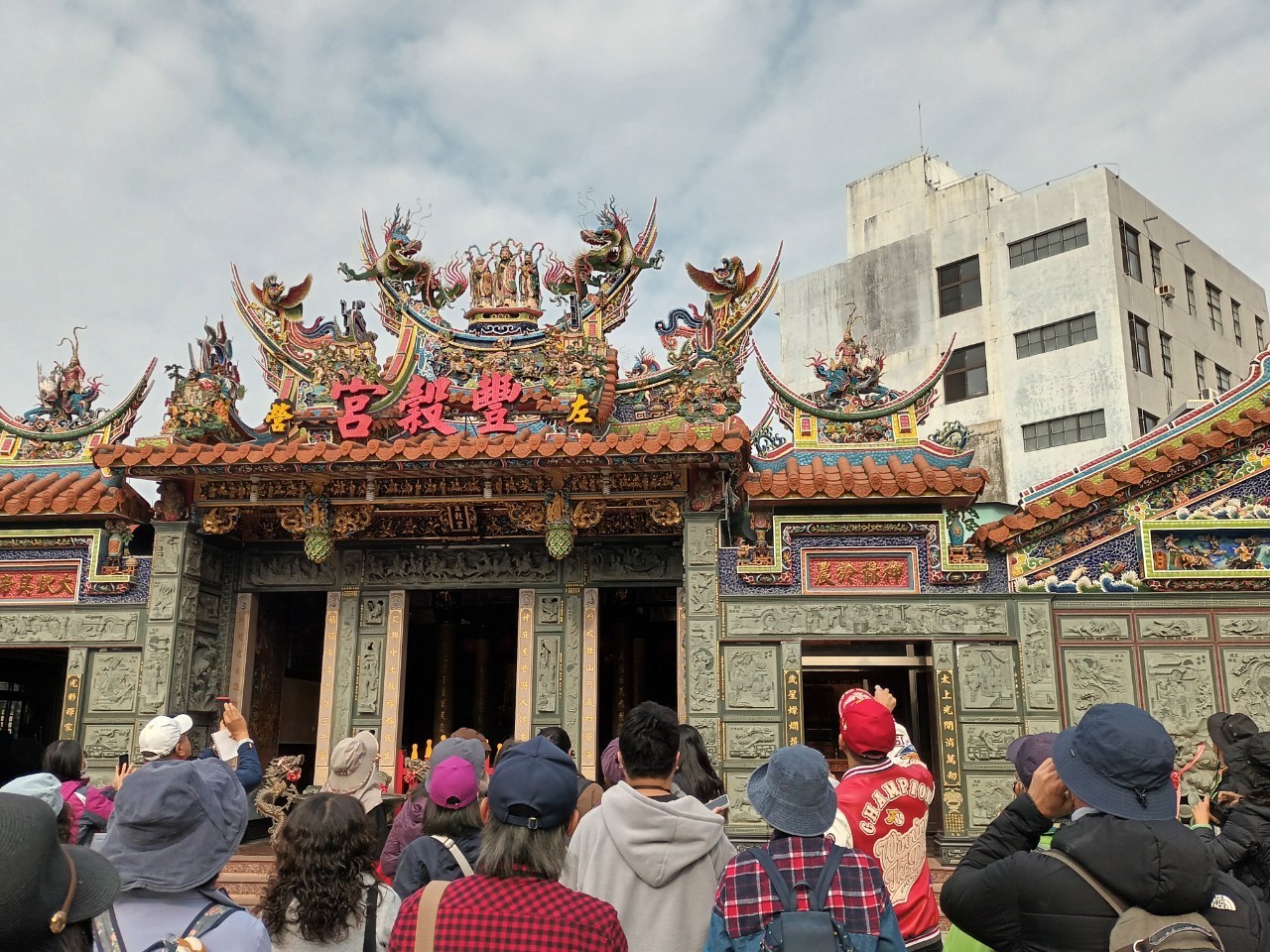
The lecturer Wu Yonglian introduced the history and significance of Fenggu Temple.
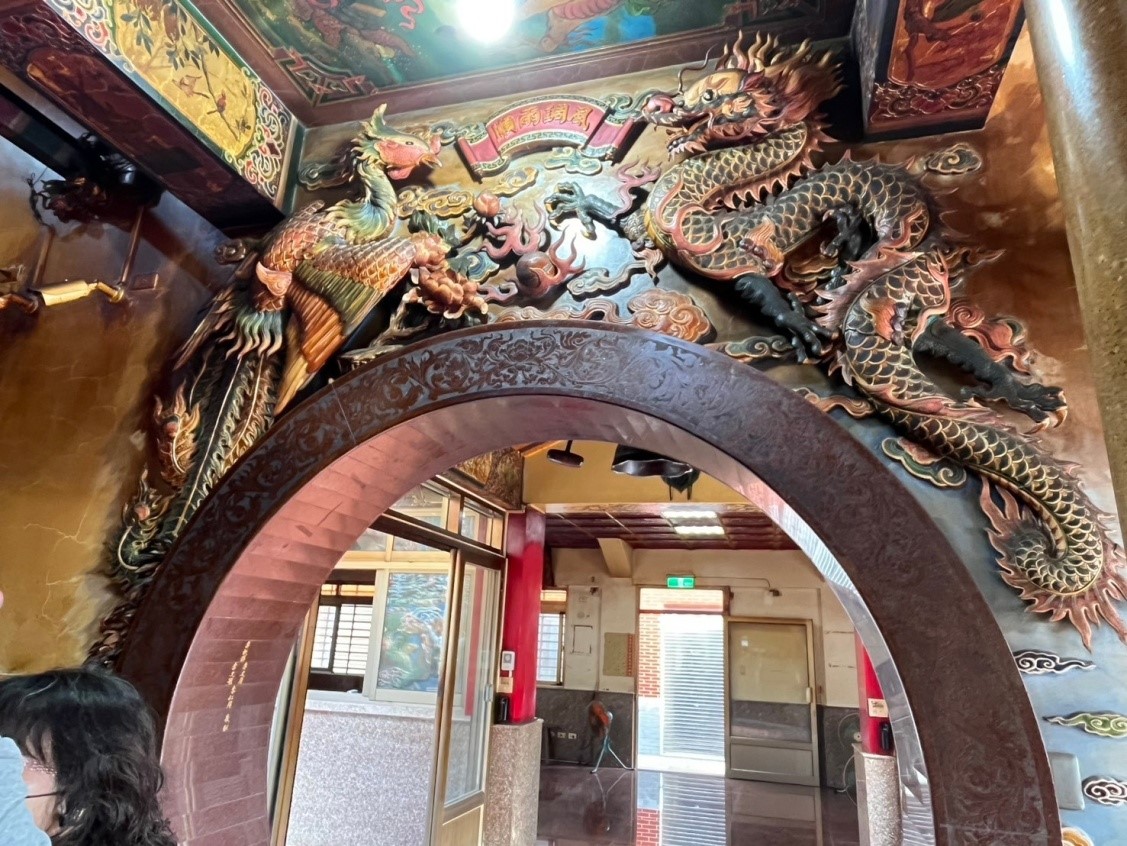
The dragon and phoenix sculptures inside Zuoying Fenggu Temple.
Yijia Alley
Did you know? In the past, settlements in Zuoying were divided into units called "Jia." Each Jia consisted of 10 households and had its own guardian deity for protection. These Jia were arranged sequentially from north to south, forming a unique community layout with a total of seven Jia.
Although the names of these settlements have changed over time, historical street names such as Yijia Alley, Erjia Alley, and Sanjia Alley still remain along Zuoying’s lower road, preserving the rich historical atmosphere that can be felt everywhere.
Steamed peanuts
In Yijia Alley, there is a traditional home that has preserved an ancient craft and specializes in making steamed peanuts! Using old-fashioned steaming techniques, they ensure the peanuts retain a rich aroma and soft texture, making them a quintessential example of Taiwan’s nostalgic snacks.
This simple yet delicious treat is so irresistible that you can’t help but keep eating! Doesn’t it make you want to try it yourself?
White gourd sugar
Hidden in the alleys of Yijia is a humble yet story-filled old shop—Ji Tai Hang! Although the shop offers a limited selection, it has preserved the tradition of hand-crafting its products. For decades, its nostalgic flavors have continued to captivate Zuoying.
The shop’s specialties are rock sugar and white gourd sugar, sold by weight. Their white gourd sugar is particularly notable, boasting a rich caramel flavor with visible pieces of white gourd during the cooking process, eventually becoming the familiar ingredient for white gourd tea. During the Lunar New Year, the shop also offers traditional white gourd strips, evoking fond childhood memories.
Be sure to visit this warm and charming shop to experience a taste of the past!
Fried peanuts
Back in the 1960s, Zuoying was renowned as one of Taiwan’s prominent agricultural areas, primarily cultivating water caltrops. It also became a major hub for peanut distribution! At that time, shops near Zuoying Old City would purchase peanuts from areas like Kaohsiung and Pingtung, then process them, leading to a thriving peanut industry.
As time passed and urbanization replaced farmlands, the number of peanut processing businesses gradually declined. Today, only a few remain, and “Yongfeng peanut brittle” stands as one of the enduring witnesses to this history. Founded by the grandfather of Brother Yu in the Yu family’s ancestral house, the business is now in its third generation.
Brother Yu personally oversees every step of the process, from raw peanuts to finished peanut candy, with each batch reflecting his confidence and dedication to quality. His meticulous craftsmanship invites you to savor this unique taste of tradition and experience the authentic flavors of Zuoying.
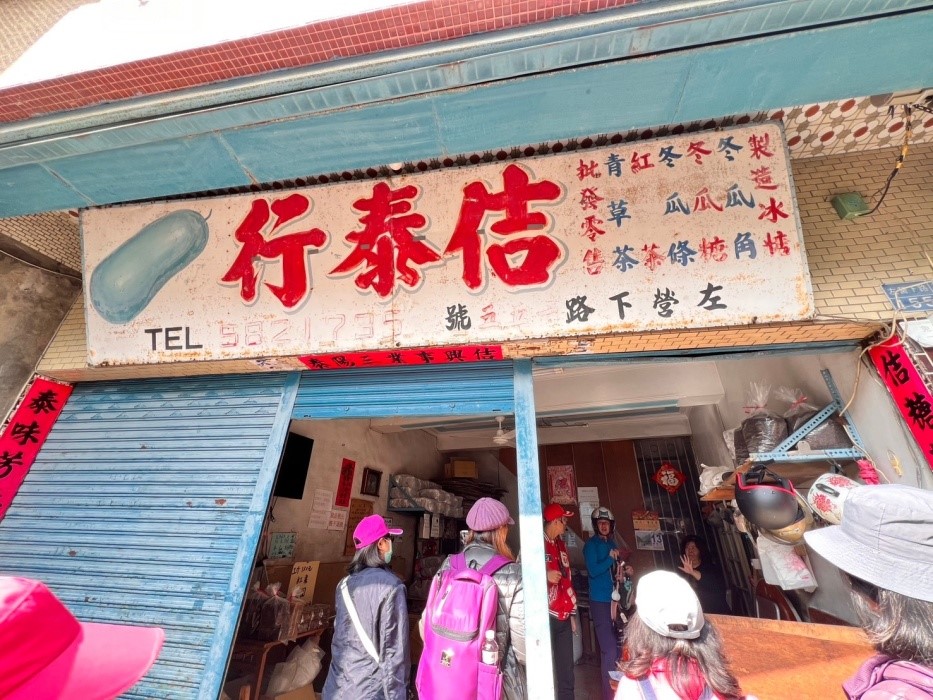
The traditional white gourd sugar shop "Ji Tai Hang."
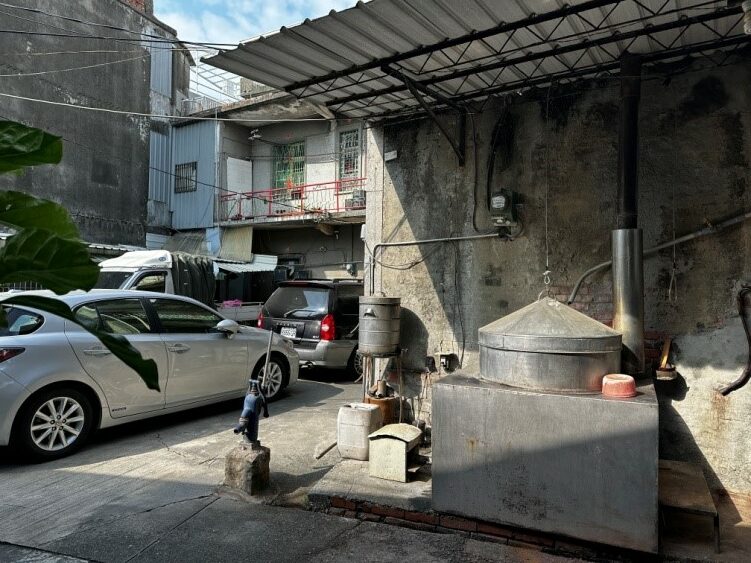
Steamed peanuts in the alleys of Yijia.
Yu Family Ancestral House(Shanhai zhen)
Located in the old Yijia settlement of Zuoying, the Yu Family Ancestral House is a precious historical structure from the Qianlong period of the Qing Dynasty. This official residence retains its main hall and is notably the birthplace of former county magistrate Yu Teng-fa.
Stepping into the courtyard, you’ll find the well-preserved Dragon and Tiger Twin Wells and a Qing Dynasty alley well. The entire setting exudes a rustic and profound historical charm. One of the most striking features is the " Shanhai zhen " plaque at the entrance. This plaque serves as a symbol of protection, warding off negative energies and enhancing the household's fortune.
The inscription on the plaque reads: "My home is like the mountains and seas; no harm can come to me," symbolizing the home’s natural resilience against harmful influences. This ancestral house, steeped in stories and history, is a must-visit to fully appreciate its unique historical atmosphere and cultural significance.
Pickles
Speaking of pickled delicacies, they represent an ancient craft filled with wisdom! These pickled foods are primarily made from vegetables, offering a rich combination of sour, salty, and spicy flavors. Not only do they satisfy the palate, but they also served as an excellent method in the past to preserve abundant produce and extend its shelf life.
While modern preservation methods and containers are now widely available, traditional fermentation jars were the go-to tools for pickling food in earlier times.
Zeng family ancestral temple (Hutian Temple) Sanxing of spirit screen
The Zeng family ancestors settled in Zuoying during the Kangxi period of the Qing Dynasty. The clan chose to reside on the elevated land of the lower road, where they dug a well for water. As the family grew, their homes expanded uphill toward Zuoying Main Road and downhill to the edge of Lotus Pond, making the northern part of Erjia Alley almost entirely Zeng family land.
The ancient well in front of the Zeng family ancestral house was the original water source for the clan. Even those living at higher elevations would come here to draw water and carry it back home. The lower part of the well is made of coral stone, forming a round wall, while the upper part is a short, circular wall made of bricks. The spring water is clear and sweet, earning it the title of "the wellspring of life" in the area.
Interestingly, a legend about the well has been passed down through generations. It is said that a white horse resides in the well, cultivating itself spiritually. At midnight, the horse quietly emerges to forage for food and returns to the well before dawn. While many of the Zeng family members have since moved elsewhere, this tale of the white horse continues to be told on Zeng family land, adding a touch of mystery to the ancestral site.
Uphill from the Jishan family ancestral house is the Zeng family ancestral temple, known as Hutian Temple. Originally a traditional grand residence, the exact details of its original door plaque are now lost to history. However, after the war, it was renovated into an ancestral temple. In addition to housing the memorial tablets of their ancestors, the temple also venerates Guanyin and Mazu, reflecting the family’s deep reverence for their faith.
In the courtyard, the "Sanxing of spirit screen" stands prominently at the front. This spirit screen is more than just decoration—it symbolizes long life, prosperous descendants, and abundant wealth. It is a meaningful representation of blessings for the family’s continued success and harmony.
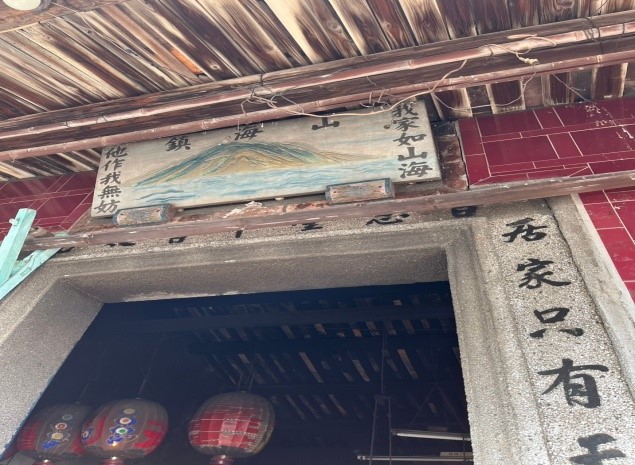
The image displays the "Shanhai zhen" plaque, which is used to ward off negative energies and enhance the household's fortune.
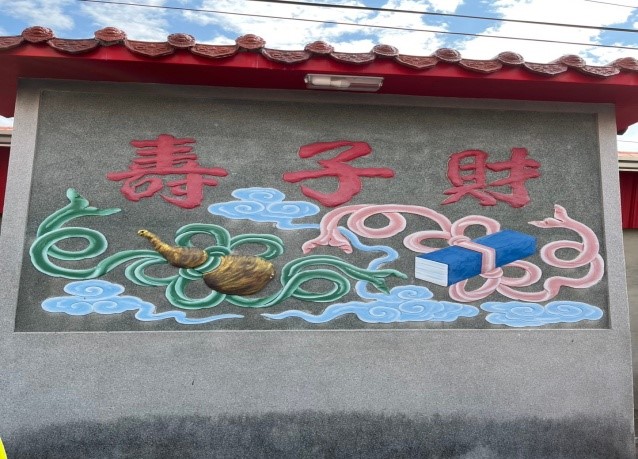
The right image displays the Sanxing of spirit screen.
Wu Family Ancestral House (Wind Lion God, Earthen bricks wall)
Located in Yijia Alley near the Wu Family Ancestral House, if you look up, you'll spot a Wind Lion God standing proudly on the roof! This guardian deity in traditional culture combines the imagery of a warrior and a lion. Its majestic design not only conveys strength but also serves to ward off evil, stabilize feng shui, and protect the home.
Particularly in coastal regions, where houses are often battered by strong sea winds, the Wind Lion God proves invaluable. It not only "tames the wind" but also symbolizes the power to resist natural disasters, safeguarding the household.
The houses here are truly unique! The walls are constructed using a straw method, where mud mixed with straw is dried and layered. This technique reflects the simplicity and ingenuity of early residents' building practices.
The roofs are covered with traditional tiles, which are not only functional but also add a nostalgic charm. Adding to the intrigue, there is the spirit screen situated opposite the house. This is no ordinary decoration—it is a "feng shui talisman" designed to block negative energies and ensure peace and safety for the inhabitants.
Guanyin Temple
Located in Erjia Alley, the Guanyin Temple is a prominent highlight of cultural faith! As early as the late Han Dynasty, the Han people began worshiping Guanyin. Interestingly, before the Song Dynasty, depictions of Guanyin Bodhisattva were predominantly male.
With the spread and evolution of the belief, Guanyin gradually transformed into a compassionate female figure, embodying maternal love and the vow to save all beings. You might have heard the story of Princess Miaoshan, a classic representation of Guanyin's feminized image.
Another explanation suggests that Guanyin adopted a female form to better connect with women in distress. By doing so, she avoided the constraints of traditional gender interactions, enabling her to provide solace and aid more effectively.
This compassionate and wise transformation not only highlights the comfort that faith brings to the human heart but also underscores the significant role of Guanyin Temple in cultural preservation and spiritual heritage.
Su Family Martial Hall (Spirit screen, Jia-Dung Inlaid Shi-Liou)
The Su family is one of the prominent clans in the Erjia area of Zuoying! Their ancestral roots trace back to Putian, Fujian Province, China. They migrated to Taiwan during the Kangxi period of the Qing Dynasty and settled in the Erjia area of Zuoying, becoming a significant family in the region.
One of their notable structures is the Su Family Martial Hall, which features distinctive architectural design. It is situated between two taller buildings, a feng shui challenge referred to as “the Heaven's Slash”. If not properly addressed, it is believed this could negatively impact the family's fortune and health. To counter this, the spirit screen was installed outside the hall. This spirit screen not only blocks prying eyes but also reflects light to brighten the interior. Additionally, it helps balance feng shui and prevents external disturbances, making it highly functional.
Inside the hall lies a hidden gem of traditional craftsmanship—the " Jia-Dung Inlaid Shi-Liou Table". Also known as “Marquetry”, this technique combines the Jia-Dung and Shi-Liou. The differing hardness and colors of these woods are skillfully carved and inlaid to create breathtaking works of art.
Whether it’s the architectural design or intricate craftsmanship, the Su Family Martial Hall showcases the unique charm of traditional culture!
That concludes this fascinating introduction to the cultural and historical walking tour. From historic architecture to culinary delights, every aspect leaves a lasting impression. Plan your visit soon and experience the rich stories of this land for yourself!
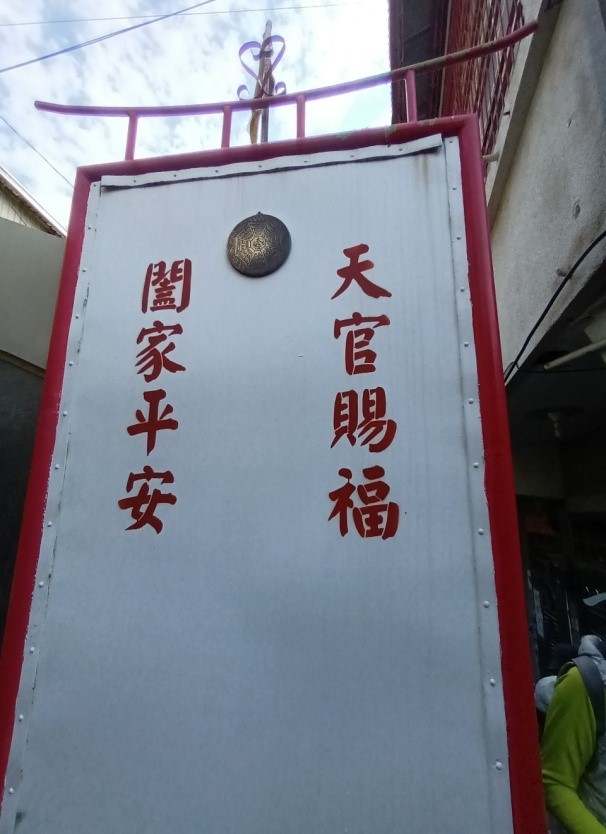
The image displays the Wu family spirit screen.
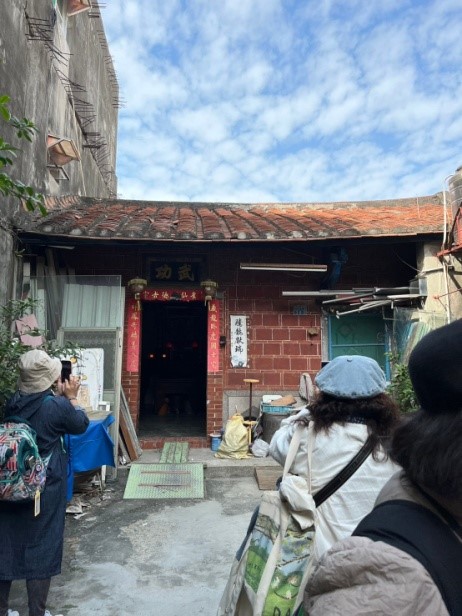
The image shows the Su Family Martial Hall.
